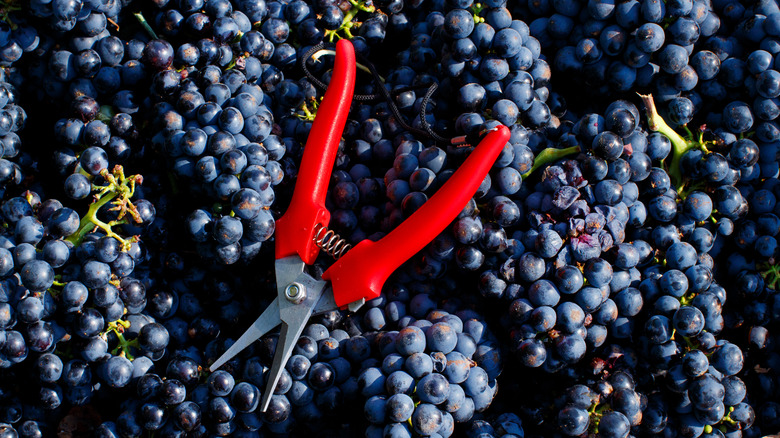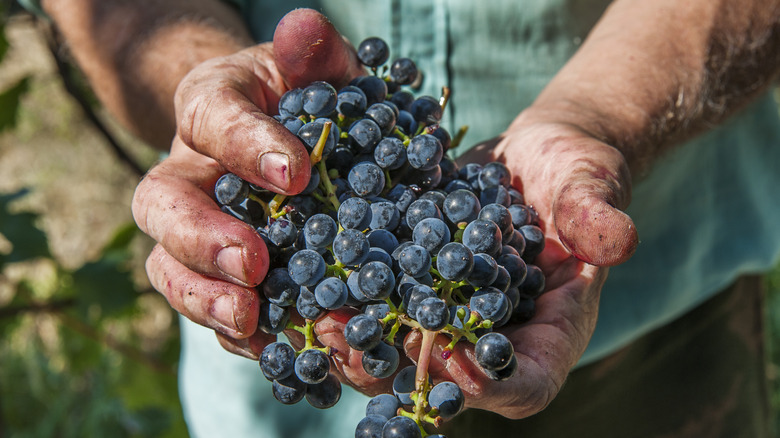Susumaniello Is The Italian Wine Variety You're Likely Missing Out On
Obscure wine lovers, do we have a grape for you. Susmaniello grapes hail from Italy's southern Salice Salento province and are one of the world's rarest varieties used to make wine, according to Wine Searcher. Thanks to the piqued interest of discerning wine connoisseurs and the commitment of a few dedicated wine-making Italian families, these unique blends have persisted, and bottles can be found in wine cellars throughout the world.
Wine Searcher explains that Susumaniello's name itself is of interest, a derivative of the Italian "somarello" which can be translated into the word "donkey." Whether this high-yielding grape is able to carry heavy loads like a donkey or simply the fruits grow in clusters similar to the way in which donkeys stand in groups, the name has stubbornly held on. Marked with the prestigious DOC label, the wine is known for exceptional quality and production associated with a specific place (via MasterClass).
History of Susumaniello grapes
Tenute Rubino describes Susumaniello as the soul of Salento, the perfect location for these dark grapes to thrive, but how, exactly, these grapes came to grow in the area is less certain. Wine Searcher attributes one theory to an aquatic journey from either the coast of Greece or Croatia to Puglia, and DNA profiling of the grape trace lineages to Garganega, a grape used to make white wines, a Puglian grape, and the equally-rare Dorona di Venezia, an exclusive category of grapes found only on one particular Venetian island.
We have the Rubino family to thank for the continuation of Susumaniello, notes Lu Cucina Italiana, as this group of Apulian winemakers expanded a few dozen hectares of the grapes into vineyards stretching across several hundred acres. As described on the Tenute Rubino website, Tommaso Rubino started making wines in the early 1980s, and the family has since taken on the project to carry the legacy forward, promoting the unique variety that was once discarded by winemakers focused on other yields (per Tenute Rubino).
Flavor profile and food pairings
The skin of Susamaniello grapes has more concentrated levels of anthocyanins, resulting in a darker color and more complex, textured wines with notable structure and finishes that dance on the palate, Tenute Rubino explains. The grape can be used for "long-aged reds," rosés, and even a few sparkling wines, notes La Cucina Italiana, and the techniques used to extract tannins and decrease temperatures during processing have improved since the first vintage Torre Tests, Tenute Rubino's 100% Susumaniello DOC 2001 red was produced. The grapes are often blended with Negroamaro, resulting in rich, red colors and aromas of chocolate, pepper, berries, and plums, Wine Searcher explains.
Lu Cucina Italiana notes that with age, Susumaniello wine grows more complex — perfect to pair with meats, game, and grilled dishes. For seafood items, reach for the rosé, and for appetizers, pop open some bubbles to share. Wine Searcher specifically recommends matching Susumaniello wines with braised beef, pork spare ribs, and venison.
Varieties made with Susumaniello grapes
Up until the 1990s, Susumaniello grapes were primarily blended into other wine varieties, per Vinorandum, but now producers have focused on creating wines made strictly from these grapes alone. The Wine Chef asserts these grapes can hold their own in blends, offering structure and aromas borrowed from sandy soil and windswept environments to gain highly-regarded recognition from the prestigious Gambero Rosso wine guide.
Tenute Rubino clarifies that the time in which the Susumaniello grapes are harvested can impact the taste of the wine; the vineyard's Torre Testa, a complex and elegant wine, is made with grapes from late-September harvests, while the fresh and fruity Oltremé is made from mid-September grapes. To make the sparkling single-vintage Sumaré, grapes are harvested before they are fully ripened so that in-bottle fermentation can occur, and grapes harvested in the first week of September result in a fresh, flavorful rosè. It's clear that once you step inside the world of Susumaniello, you'll have plenty to explore.



